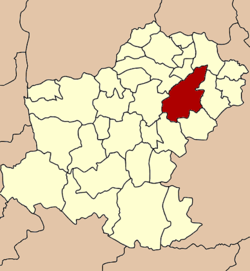Amphoe Phimai
|
Phimai พิมาย |
|
|---|---|
| Amphoe | |
 Amphoe location in Nakhon Ratchasima Province |
|
| Coordinates: 15°13′14″N 102°29′9″E / 15.22056°N 102.48583°ECoordinates: 15°13′14″N 102°29′9″E / 15.22056°N 102.48583°E | |
| Country |
|
| Province | Nakhon Ratchasima |
| Seat | Nai Mueang |
| Area | |
| • Total | 896.9 km2 (346.3 sq mi) |
| Population (2000) | |
| • Total | 130,296 |
| • Density | 145.3/km2 (376/sq mi) |
| Time zone | THA (UTC+7) |
| Postal code | 30110 |
| Geocode | 3015 |
Phimai (Thai: พิมาย) is a district (amphoe) in the northeastern part of Nakhon Ratchasima Province, northeastern Thailand.
Phimai was an ancient Khmer city named Vimai or Vimayapura. A stone pillar dating to the reign of King Suryavarman I was found, naming the city Bhirapura meaning strong city. Phimai was the important city ever since, both during Ayutthaya and Rattanakosin times.
Mueang Phimai district was officially established in 1900. Khun Khachit Sarakam (ขุนขจิตสารกรรม) was the first governor.
Queen Mother Sriphatcharindra (Saovabha) visited Prasat Phimai and Sai Ngam (Ficus forest) in 1911. The government officers and people renovated the city for the royal visit, and named six roads to commemorate the event.
In 1940 the government renamed the district by cutting the word Mueang off.
The district is subdivided into 12 subdistricts (tambon), which are further subdivided into 208 villages (muban). There are two subdistrict municipalities (thesaban tambon) - Phimai covering parts of tambon Nai Mueang. and Rang Ka Yai the whole part of tambon Rang Ka Yai. There are further 12 Tambon administrative organizations (TAO).
...
Wikipedia
